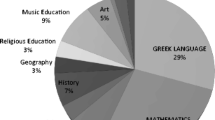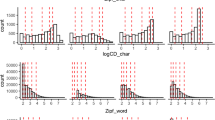Abstract
Acquiring vocabulary is important when studying English, as it assists in listening, speaking, reading, and writing. In this paper, we develop an English webpage corpus (EWC) and create a word frequency list using web crawler technology. By comparing EWC word lists with the British National Corpus (BNC), we find that the BNC word frequency list possesses the feature of timeliness. We also explore primary school students’ English word recognition rates by comparing the word frequency lists of several corpora, including EWC, BNC, SUBTLEX-US, and Subtitle Corpus of Children’s BBC (CBBC). The results show that the word recognition rates for primary school children are relatively low in both general language and specific language register. Motivated by the experiment results, we finally propose some word-selection strategies for compiling English textbooks for Chinese primary school students.
Similar content being viewed by others
References
Beijing Educational Scientific Academy (BESA), 2001. Reflections on the current evaluation system of foreign language teaching and the importance of formative assessment in foreign language teaching, For. Lang. Teach. Schools (Middle Vers.), 24(6): 1–4(in Chinese).
Brysbaert, M., New, B., 2009. Moving beyond Kučera and Francis: a critical evaluation of current word frequency norms and the introduction of a new and improved word frequency measure for American English. Beh. Res. Meth., 41(4): 977–990. http://dx.doi.org/10.3758/BRM.41.4.977
Brysbaert, M., Buchmeier, M., Conrad, M., et al., 2011. The word frequency effect: a review of recent developments and implications for the choice of frequency estimates in German. Exp. Psychol., 58(5): 412–424. http://dx.doi.org/10.1027/1618-3169/a000123
Cunningsworth, A., 1995. Choosing Your Coursebook. Heinemann Publishers, Oxford.
Fu, Y.C., 2013. A Vocabulary Study in Textbooks for Primary School and Junior High School Students. MS Thesis, Nanjing Normal University, China (in Chinese).
Halliday, M.A.K., Hasan, R., 1976. Cohesion in English. Longman, London, UK.
Jescheniak, J.D., Levelt, W.J.M., 1994. Word frequency effects in speech production: retrieval of syntactic information and of phonological form. J. Exp. Psychol. Learn. Mem. Cogn., 20: 824–843.
Kennedy, G., 1998. An Introduction to Corpus Linguistics. Longman.
Kilgarriff, A., 1995. BNC database and word frequency lists. http://www.kilgarriff.co.uk/bnc-readme.html
Kilgarriff, A., 1997. Putting frequencies in the dictionary. Int. J. Lexicogr., 10(2): 135–155. http://dx.doi.org/10.1093/ijl/10.2.135
Lang, J.G., Li, J., 2009. On English frequent words and frequency annotations of four English learners’ dictionaries. For. Lang. Teach. Res., 42(1): 61–66(in Chinese).
Leech, G., 2001. The role of frequency in ELT: new corpus evidence brings a re-appraisal. For. Lang. Teach. Res., 33(5): 328–339.
Lei, L., Liu, D.L., 2016. A new medical academic word list: a corpus-based study with enhanced methodology. J. Engl Acad. Purp., 22: 42–53. http://dx.doi.org/10.1016/j.jeap.2016.01.008
Lenneberg, E.H., 1967. Biological Foundations of Language. Wiley, New York.
Liang, M.C., Li, W.Z., Xu, J.J., 2010. Using Corpora: a Practical Coursebook. Foreign Language Teaching and Research Press, Beijing.
Liu, L., 2014. An Evaluation of 2012 PEP Primary English. MS Thesis, Ludong University, China (in Chinese).
Liu, X.C., Sun, Y.J., 2013. Research on correlation of English vocabulary class information processing and comprehensive English ability. Inform. Sci., 34(7): 64–67(in Chinese).
Monsell, S., Doyle, M.C., Haggard, P.N., 1989. Effects of frequency on visual word recognition tasks: where are they? J. Exp. Psychol. Gen., 118(1): 43–71. http://dx.doi.org/10.1037/0096-3445.118.1.43
Nation, I.S.P., 1990. Teaching and Learning Vocabulary. Heinle ELT, London, UK.
Nation, I.S.P, 2001. Learning Vocabulary in Another Language. Cambridge University Press, London, UK.
Nation, P., Waring, R., 1997. Vocabulary size, text coverage and word lists. In: Schmitt, N., McCarthy, M. (Eds.), Vocabulary: Description, Acquisition and Pedagogy. Cambridge University Press, London, UK.
Rietveld, T., van Hout, R., Ernestus, M., 2004. Pitfalls in corpus research. Comput. Human., 38(4): 343–362. http://dx.doi.org/10.1007/s10579-004-1919-1
Schmitt, N., 2010. Researching Vocabulary: a Vocabulary Research Manual. Palgrave MacMillan.
Shi, S.T., 2015. A Research on the Vocabulary Setting of Primary School Textbooks and the Students’ Communicative Competence. MS Thesis, Shanghai Normal University, China (in Chinese).
Sinclair, J., 1996. Preliminary Recommendations on Corpus Typology. EAGLES Document TCWG-CTYP/P. http://www.ilc.cnr.it/EAGLES96/corpustyp/corpustyp.html
Spolsky, B., 1998. Sociolinguistics. Oxford University Press.
Sun, W.K., 2005. On the compilation principles and methods of English teaching vocabulary syllabus of basic education— with comments on vocabulary syllabus of basic education. Curricul. Teach. Mat. Meth., 25(3): 61–65(in Chinese).
Svartvik, J., 1996. Corpora are becoming mainstream. In: Thomas, J., Short, M. (Eds.), Using Corpora for Language Research. Longman, London, p.3–13.
Thornbury, S., 2006. How to Teach Vocabulary. Pearson Education, India.
Trudgill, P., 2000. Sociolinguistics: an Introduction to Language and Society. Penguin, UK.
van Heuven, W.J.B., Mandera, P., Keuleers, E., et al., 2014. SUBTLEX-UK: a new and improved word frequency database for British English. Q. J. Exp. Psychol., 67(6): 1176–1190. http://dx.doi.org/10.1080/17470218.2013.850521
Verschueren, J., 1999. Understanding Pragmatics. Oxford University Press.
Wang, Z.Q., Wu, X., 2008. The construction of corpus of English textbooks in China and its application in primary English textbook writing. Curricul. Teach. Mat. Meth., 6: 53–57(in Chinese).
Wardhaugh, R., 1972. Introduction to Linguistics. McGraw-Hill, New York.
White, R., 1998. The ELT Curriculum: Design, Innovation and Mangement. Wiley-Blackwell.
Wilkins, D.A., 1972. Linguistics in Language Teaching. PhD Thesis, Edward Amold, London.
Xie, J.C., He, A.P., 2008. A study on the appendix vocabulary of middle school English textbooks. For. Lang. Teach. Schools (Middle Vers.), 31(9): 1–5(in Chinese).
Zhang, W., Ma, G.H., 2007. Analysis on the vocabulary of Go for It. For. Lang. Teach. Schools (Middle Vers.), 30(1): 9–13(in Chinese).
Zhao, X.B., 2007. A Study on Recognition and Extraction Method of Contemporary Chinese Basic Vocabulary Based on Dynamic Circuit Corpus. PhD Thesis, Beijing Language and Culture University, China (in Chinese).
Zhu, X.M., 2013. A Study of Second Language Function Words Acquisition Based on Attention Theory. MS Thesis, Sichuan International Studies University, China (in Chinese).
Acknowledgements
We thank the reviewers for their helpful comments and suggestions. We also appreciate Xiong-fei XU and Zhi-ming CHEN for assistance with the experiments, and Dr. Jin-shan ZENG and Dr. Hong-wei LI for valuable discussion.
Author information
Authors and Affiliations
Corresponding author
Additional information
Project supported by the National Natural Science Foundation of China (Nos. 61272212, 61462043, and 61462045) and the Graduates Innovation Fund of Jiangxi Normal University, China
ORCID: Wen-yan XIAO, http://orcid.org/0000-0001-6253-2414
Rights and permissions
About this article
Cite this article
Xiao, Wy., Wang, Mw., Weng, Z. et al. Corpus-based research on English word recognition rates in primary school and word selection strategy. J. Zhejiang Univ. - Sci. C 18, 362–372 (2017). https://doi.org/10.1631/FITEE.1601118
Received:
Accepted:
Published:
Issue Date:
DOI: https://doi.org/10.1631/FITEE.1601118




